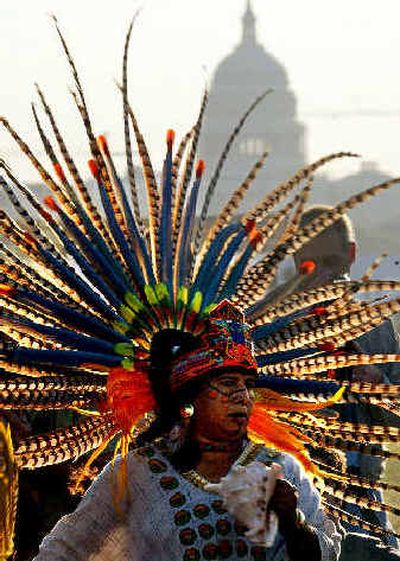‘A long time coming’

WASHINGTON – After 15 years of planning, nearly $200 million in construction and efforts to amass artifacts from around the Western Hemisphere, the National Museum of the American Indian opened Tuesday with thousands of the people it seeks to represent.
“It’s been a long time coming,” said Francis SiJohn as he and other members of the Coeur d’Alene Tribe assembled on the National Mall. SiJohn talked about the museum as the smell of burning sage floated on the breeze.
To him, the museum represents a way for American Indians to tell their story in their own words. “It has a lot of traditional values,” he said.
Some 20 Coeur d’Alenes came to the morning opening, most in traditional dress. SiJohn and others visited the Smithsonian Institution archives later Tuesday to say a blessing over artifacts from Idaho.
Some museums have angered tribes for hoarding religious objects and human remains. The Smithsonian’s 800,000 artifacts for the new museum came largely from existing collections and donations from tribes.
Donating family heirlooms can be a hard choice to make, but for many, collections like this one are a way to preserve their culture.
“Unless someone is willing and able to do that, no one will know what is true Nez Perce,” said Kerma Greene, of Lapwai, Idaho, who wore a dress of black wool adorned with intricate beadwork that originally belonged to her mother and is probably nearly 80 years old. Of the approximately 50 Nez Perce at the opening ceremonies, about half are her relatives, including her 4-year-old niece.
“We want her to see that there are Indian people from all over the United States,” she said as she pointed out the regional patterns of colorful tribal dress on people around her.
Organizers estimated that more than 10,000 Native Americans from Alaska to Peru made their way down the mall from the oldest Smithsonian building near the Washington Monument to the new museum. Of those, about 270 came from Washington state and 75 from Idaho.
“We were well-represented today,” said Samuel Penney, a Nez Perce tribal executive committee member.
Greg Abrahamson, of the Spokane Tribe, said he hoped the museum will spark interest for others to learn more about Native Americans.
“It was a really moving experience to see the population of tribal people here,” Abrahamson said.
After the procession, Smithsonian officials, politicians and even the president of Peru thanked the people and organizations that made the museum possible. The idea for a museum for America’s indigenous people was first introduced in Congress in 1989. Since then, close to $100 million in private funds were raised for the project, and planners navigated the politics of satisfying hundreds of different groups.
The end result is a building that stands in striking contrast to its classically constructed neighbors. Designed by a Canadian Blackfoot architect, the museum’s 250,000 square feet curve and flow like a Southwest landscape.
As for its location, it is “probably the last remaining spot on the mall,” said Penney. “That’s significant.”
W. Ron Allen, of the Jamestown S’Klallam tribe in Washington, is a former president of the National Congress of American Indians. He consulted with the people who planned the museum.
“Fifteen years, considering we are capturing a 10,000-year history, that’s not long,” he said.
He hopes the museum serves to tell people about Indians, not only historically, but as they live today. Allen, Penney and others usually visit the Capitol for more dire concerns, such as federal funding for health programs, land rights and other issues.
“This is a museum that should educate them as much as anyone,” Allen said of Congress. He hopes the museum will help encourage federal policies that make more independent an ethnic group that he said has the highest unemployment rates in the country.
Nonetheless, Allen said the museum is “outstanding” and respectful of the people it represents.
“It is a positive step,” he said.